9.8 User Defined Vehicles and Convoys
Subjects Covered
- User Defined Vehicles
- User Defined Convoys
General Background
User Defined Vehicles and Convoys can be used when a vehicle is not included in the list of default vehicles available in Autodesk Structural Bridge Design.
In this example a user defined convoy is created to represent a train of two Assessment Load Wagons in accordance with Network Rail's 'Structural Assessment of Underbridges' document'. Each of the 4 bogies in the 2 wagons will be defined as individual user defined vehicles which will ensures that the orientation of each bogie remains radial when the train is applied to a curved track.

It is worth noting that both user defined 'Road' vehicles and convoys can be used in a 'Road' Load Optimisation within Autodesk Structural Bridge Design but only a convoy of user defined 'Rail' vehicles can be used.
Outline
A pre-prepared two span grillage model of a 500mm thick, curved slab, as shown below is supplied with dead and superimposed loads already applied. A convoy load which will represent two Assessment Load Wagons will also be applied.

Details of the characteristic loads are as follows (4 dead loads already applied):
- Dead load of the concrete slab is 25kN/m³ (γG = 1.35)
- Ballast 0.3m deep x 1.3 (Table NA1 of EN1991-1-1). Density 20kN/m³ (γG = 1.35)
- Track and sleepers 5kN/m (γG = 1.35) • Footway loading 7kN/m² (γG = 1.2)
- 2 Assessment Load Wagons as outlined above (γQ = 1.45)
Procedure
Start the program, close the Home using the
ESCkey and open the supplied data file “EU Example 9_8 grillage.sst” via the menu item Help | Tutorials | Open Tutorial Model.Close the Project Overview with the “Done” button.
Change the title of the example to “Curved Grillage Model with Convoy Load” using the Date | Titles menu option and put your initials in the Calculations by: field before closing the form in the normal way.
User Defined Special Vehicles
The dead and superimposed dead loads of the slab, ballast, track, sleepers and footways have been applied already in the pre-prepared file. The bogies, each containing 2 axles, will be defined as user defined special vehicles.
Select the menu item Data | Define Special Vehicles... to open the Define Special Vehicles form.
Click on the + button to add a new special vehicle and change the Name to “Wagon Bogie”.
Set the Number of Axles and Number of Tracks to “2” and enter a value of “125kN” in the Nominal Wheel Load field. This will ensure that each of the 4 wheel loads has the same value, although different wheel loads can be entered directly in the Load column if required.
In the Edit field select “axle spacing” from the drop down list.
On the sub form that has opened enter a value of “1.829” on the second row of the table. This will ensure that the axle spacing in the bogie is 1.829 metres as per the vehicle load diagram.
Click ✓ OK to close the sub form.
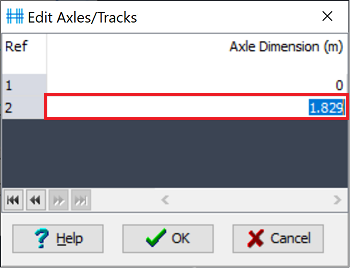
In the Edit field select “track spacing” from the drop down list.
On the sub form that has opened enter a value of “1.435” on the second row of the table. This will ensure that the track spacing in the bogie is 1.435 metres as per the standard track spacing.
Click ✓ OK to close the sub form.
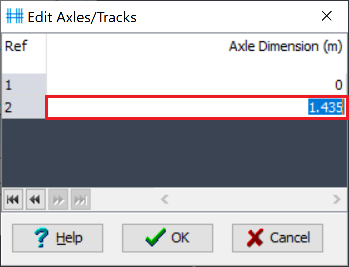
In this example the default value of “1.935m” for the Overall Width of Vehicle will be used. Note that the program automatically alters this default value when the value of the track spacing is set.
We will now define the 4 wheels in the bogie as being at the 4 locations where the blue construction lines intersect.
Select “wheel positions” in the Edit field and click “Yes” on the confirm form.

The 4 wheels in the bogie have been defined and are represented by green circles on the graphics window. Note that as an alternative the wheels could be defined by clicking in the graphics window at the locations where the blue construction lines intersect.
Set the Front Axle Overhang and Rear Axle Overhang fields to “1.464m”. This would ensure that the appropriate swept path allowance would be set correctly if the convoy were to be considered in the Load Optimisation process.
In this example we will use the default value of “5m” for the Unloaded Length Front and Unloaded Length Back fields. This will ensure that no load is applied to the structure over that length immediately in front of, or behind, each bogie/vehicle. It is worth noting that, as an alternative, the unloaded length can be set in the EN1991-2 tab of the Nationally Determined Parameters form. Toggling between the 2 radio buttons at the bottom of the form determines whether the unloaded length value is set by the value on the NDP form or the Define Special Vehicles form. However, the unloaded lane length only effects road vehicles and hence it is not directly relevant to the rail loads specified in this example.

The Define Special Vehicles form will now be as shown below.
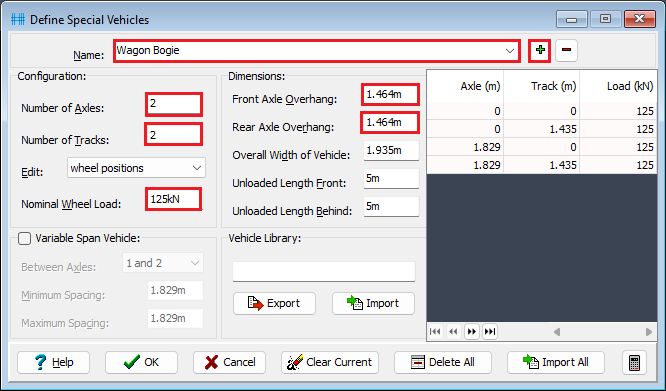
Click ✓ OK to close the Define Special Vehicles form.
Convoy of Vehicles
The train will be defined as a single convoy of 4 bogies, each of which will consist of the user defined vehicle “Wagon Bogie”.
In the main menu select Data | Define Convoy... to open the Define Convoy of Vehicles form.
Click on the + button to add a new convoy and change the Name to “Two Wagon Convoy”.
Set the Convoy Type to “Non-uniform”. This will enable bogies to be positioned at varying distances within the convoy.
Set the Vehicle Type to “Wagon Bogie” in the top 4 rows of the table and enter the values shown below in the Vehicle Separation fields. These dimensions position the bogies along the length of the convoy as per the diagram in the introduction to this example.
Click ✓ OK to close the form.
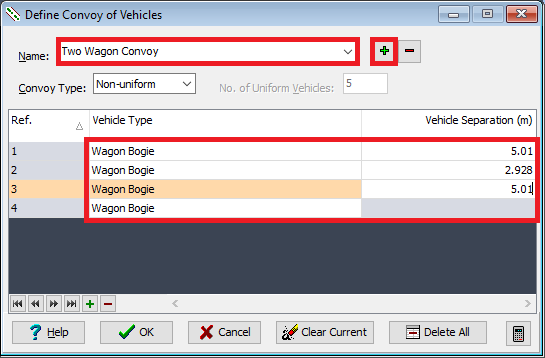
Applying the Convoy Load to the Structure
A rail convoy load can be included in the Load Optimisation process. However, in this example the convoy load will be applied manually to the structure.
Change the navigation window on the left hand side of the screen to Structure Loads.
Click on the
 button in the navigation window toolbar and select Rail Traffic Load | Convoy Load to open a Define Rail Traffic Load form. Use the default values on the form.
button in the navigation window toolbar and select Rail Traffic Load | Convoy Load to open a Define Rail Traffic Load form. Use the default values on the form.Position the Convoy Load approximately by clicking twice in the north most lane somewhere near the right hand end of span 1 (leave a gap of a few seconds between clicks).
Now set the Chainage in the form to “15m” to position it more accurately. Note that the axles in the 4 bogies align radially with the curved deck.
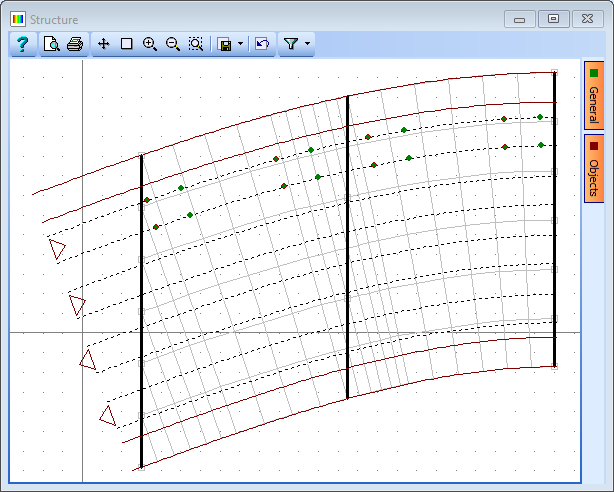
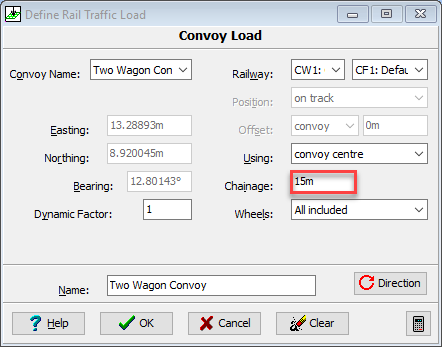
It is worth noting that when “Defined” is selected in the Wheels field the Wheels Included sub form opens in which tick boxes can be selected or deselected to include or ignore individual wheel loads in the convoy. This may be useful when a user wants to ensure that loads are not applied in relieving areas as mentioned in EN1990:AMD1:Tables A2.4(A) to (C).
Close the sub form if it has been opened.
Close the Define Rail Traffic Load form with the ✓ OK button.

In the main menu select File | Save As to save your model as “My EU Example 9_8 with Convoy Loads.sst”.
Close the program.
Summary
This example provides an introduction to defining user defined special vehicles and user defined convoys.
The user defined a special vehicle and a user defined convoy. The convoy load was placed on the structure manually. Users can create loading patterns manually based on engineering experience. The appropriate load factors would be input manually in the Compile Loading Patterns form.
Alternatively, the convoy could be included in the Load Optimisation process which is described in Section 10 of this tutorial. Obviously, any additional wagons or locomotives could be defined and included in the convoy as necessary.
